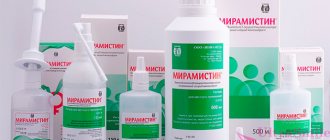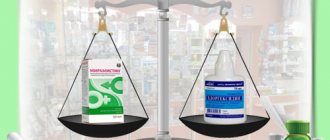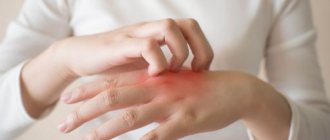The incidence of acute respiratory diseases (ARI) and their high prevalence in children are a serious problem for healthcare in Russia [1]. The pathological process during acute respiratory infection can involve both the upper and lower respiratory tracts. Etiological factors represent a polyetiological group of infections, among which in children the proportion of viruses is 65-90% [2-4]. The most common bacterial pathogens detected in acute respiratory infections in children are Str. pneumoniae, H. influenzae, Str. pyogenes, Staph, aureus, M. catarrhalis
[5]. The role of bacterial flora in the development of complications and recurrent respiratory diseases in frequently ill children is especially high [6].
In children, a complicated course of acute respiratory diseases is much more often recorded in the form of inflammatory diseases of the nasal cavity, pharynx, larynx, trachea, which have a recurrent course. Currently, the treatment of these diseases is effective when using, first of all, antiseptic agents in combination with symptomatic drugs [7, 8] and physical factors [9-11].
One of the pressing problems of modern physiotherapy is the development of technologies that allow the administration of drugs using hardware physiotherapy methods [12].
An effective method for treating diseases of the upper respiratory tract is aerosol therapy in the form of inhalation of medicinal substances that have higher chemical and physical activity than conventional liquid drugs due to an increase in the total surface of the dispersed phase.
In recent years, a new generation antiseptic, Miramistin, has been widely used, which has pronounced activity against a number of microbes - viruses, bacteria, fungi.
The purpose of the study was to scientifically substantiate the possibility of using Miramistin solution in children with acute respiratory diseases using physiotherapy technologies and increasing the effectiveness of complex treatment.
Material and methods
Clinical observations and comparative studies were carried out in 60 children with acute respiratory diseases who received inhalation of miramistin solution through a nebulizer (40 children) and in the form of a spray (20 children - control group) 2 times a day for 10 days. Inhalations were carried out through a mask using a nebulizer using 3-4 ml of a standard 0.01% aqueous solution of Miramistin. Irrigation of the pharynx was carried out with a 0.01% solution of miramistin in the form of a spray.
The effectiveness of Miramistin was assessed on the basis of dynamic observation data in accordance with the results of various research methods (general blood count, rhinoscopy, pharyngoscopy, assessment of the dynamics of subjective complaints using a sensory analogue scale (SAS) on a 10-point system, examination of external respiratory function, monitoring peak expiratory flow, studying the level of physical development and physical fitness of children).
The studies were conducted in accordance with the requirements of the Declaration of Helsinki. Statistical processing of the study results was carried out using standard computer programs Statistika 7.0 and SPSS 15.0.
Preliminary description of the solution
Before you figure out whether it is possible to rinse your nose with Miramistin, you should find out important information about the drug itself. It contains a complex chemical compound. It has antiseptic, antiviral, antimicrobial effects. Miramistin solution is odorless and tasteless. It is effective against even those bacteria that are resistant to antibiotics.
The drug is available in different forms and volumes. You can buy it at the pharmacy without a prescription. The medicine costs 175, 350 and 800 rubles, respectively, for 50, 150 and 500 milliliters of the finished drug.
Results and discussion
Before the start of the study, 45 (78.3%) children complained of poor health and malaise. In 24 (40.0%) children, rhinitis was complicated by symptoms of catarrhal sinusitis: difficulty nasal breathing, heaviness and pain in the head, in the projections of the sinuses. During rhinoscopy, 17 (28%) children had mucopurulent discharge from the nose in the middle and lower nasal passages, 43 (72.0%) had mucous discharge, 29 (48.0%) patients had hyperemia and swelling of the nasal mucosa . During pharyngoscopy, redness of the pharyngeal mucosa and mucus flowing down the back wall of the pharynx were observed in 48.1% of cases. In children, along with a runny nose, there were signs of acute pharyngitis and laryngotracheitis (24.0%), which was accompanied by a sore throat and dry cough; in 55% of cases the cough was paroxysmal in nature. In 40% of cases, complaints were made of chest pain when coughing. In 26.7% of children with symptoms of tracheitis, the cough was accompanied by the separation of viscous mucous sputum.
The presence of acute inflammatory process activity in 41.7% of children with acute respiratory diseases was evidenced by leukocytosis up to 11.08±1.4·109/l in 62.5% of them and an increase in ESR on average to 16.2±1.45 mm/h in 79.2%.
When using inhaled miramistin solution in children with symptoms of nasopharyngitis, the cough became milder, less frequent after the 2nd day of treatment, in 75% of patients it completely disappeared by the end of the course; sputum discharge improved, nasal congestion decreased, and the amount of discharge from the nasal passages decreased.
In 40% of children with symptoms of laryngotracheitis, cough complaints decreased significantly after the 4th day of inhalation. Against the background of a decrease in the number of coughing episodes in children in the main group, a change in the nature of sputum was recorded - the viscosity decreased, and the discharge acquired a mucous character. The cough became moist, more productive, its intensity decreased, which was accompanied by a significant decrease in sore throat and pain in the chest during coughing attacks. In 25% of children, the cough stopped completely after the 5th day of treatment, in half (45%) of the children - after the 7th day, in the remaining patients - after the 10th day of inhalation.
In the control group, the positive dynamics of clinical symptoms were less pronounced and occurred 3-4 days later ( Fig. 1
).
Under the influence of inhalation of Miramistin solution, favorable dynamics of the auscultatory picture were observed in the form of a decrease or disappearance of wheezing in the lungs after the 6th day of treatment in 65% of children with laryngotracheitis, in the remaining children - after the 8th day of inhalation. In the control group, the disappearance of wheezing was observed at a later date: in only 20% of children, wheezing disappeared by the end of the treatment course.
To assess the dynamics of subjective complaints, SAS was used. SAS data showed that by the end of the course of treatment, children of all groups had improved well-being and motor activity.
In children with symptoms of nasopharyngitis, nasal congestion, according to the SAS, decreased from 8.49±0.137 to 2.00±0 points, discharge from the nasal passages - from 9.25±0.155 to 2.00±0.10 points ( Fig. 2
).
In the control group, the dynamics of the severity of nasal congestion and nasal discharge decreased from 7.99±0.207 to 4.00±0.100 points and from 8.89±0.266 to 4.92±0.140 points, respectively ( Fig. 3
).
According to SAS data, after the first inhalation of miramistin solution in children with symptoms of laryngotracheitis, the intensity of cough decreased (from 9.30±0.179 to 7.70±0.193 points), weakness significantly decreased and performance increased. A significant decrease in subjective symptoms in children with symptoms of laryngotracheitis in the main group was noted after the 4th day of inhalation. In 2 children who received treatment for 10 days, by the end of treatment the severity of subjective symptoms decreased to 1 point ( Fig. 4
).
In the control group, the severity of subjective symptoms decreased gradually and by the end of the observation remained at an average level of 5.7 points.
Based on the studies conducted, a positive effect of inhalation of miramistin solution on peripheral blood parameters in children with acute respiratory infections who had initially reduced hemogram values was established, characterized by normalization of the leukocyte count and ESR in all children, which indicates an anti-inflammatory effect.
Analysis of the flow-volume curve data showed that at the beginning of the study, 70% of patients with complicated tracheitis had an average decrease in respiratory function below the age norm (POS - 69.24±0.23% D, FEV1 - 75.45± 0.67%D).
Under the influence of inhalation of miramistin solution, a tendency towards an increase in reduced indicators was noted (POS up to 73.02±0.34%D and FEV1 up to 82.36±0.41%D), but no significant dynamics were identified.
In children of the control group who received miramistin in the form of a spray, indicators of external respiration function remained at the same level.
During the study, daily monitoring of peak expiratory flow (PEF) was carried out in children with symptoms of tracheitis, which made it possible to monitor the state of external respiration and evaluate the effectiveness of the therapy. The initial PEF values in 25% of these children were below the age norm. In the course of the study, under the influence of inhalation of miramistin solution, a tendency was noted to increase the average PEF values after the 5th inhalation in almost half (45%) of children (from 66.79±0.76 to 74.22±0.62%D) , by the end of the course there was a significant increase in indicators to 78.35±0.89%D ( p
<0.05).
In children who received miramistin in the form of a spray, similar dynamics of PEF indicators were not recorded, which indicated a more pronounced positive effect of inhalations ( Fig. 5
).
Analysis of the initial level of physical fitness of school-age children with acute respiratory infections revealed a decrease in the degree of development of speed-strength capabilities in 70% of children, and a decrease in the level of development of strength capabilities in 80%.
Data from a repeated study of the functional state of the muscular system in all children after recovery indicated positive dynamics in speed-strength indicators of physical fitness (standing long jump, dynamometry).
A comprehensive assessment of the effectiveness showed a significantly higher therapeutic effectiveness of inhalation of Miramistin solution (87.5%) than when using Miramistin in the form of a spray (75.0%, p
<0.05), due to an increase in the pharmacotherapeutic activity of the drug due to an increase in the total volume of the drug suspension and the contact surface of the aerosol obtained using a nebulizer.
Treatment of a runny nose: how to rinse your nose
If you are concerned about rhinitis, consult your doctor. The doctor will conduct an examination and tell you whether it is possible to rinse your nose with Miramistin in your case. Therapy will likely require other nasal agents. Depending on the nature of the runny nose, these may be antibacterial drops, antiviral sprays, vasoconstrictor drugs or immunomodulators. How to use the drug in this case?
Before applying the medicinal substance to the nasal mucosa, rinse it. To do this, use Miramistin. Follow the given algorithm:
- Draw 10 to 15 ml of solution into the syringe.
- Bend down over the sink and turn your head slightly to the right.
- Insert the device into the right nostril and press the plunger.
- If you did everything correctly, the solution will flow out of the other nostril (not everyone succeeds the first time, don’t be discouraged).
Is it possible to rinse the nose with Miramistin only through one nostril or should the drug be administered into the other? This issue remains controversial. If the solution flowed out of the opposite hole, then, in fact, the entire mucous surface was washed. Whether to repeat the manipulation with the other nostril or not, decide for yourself. If Miramistin does not pass through the nasal septum, be sure to treat the mucous membrane of the second nostril in a similar way.
Is it possible to rinse a child’s nose with Miramistin?
This issue is always hotly discussed by pediatricians and parents of children. The answer depends on the age of your child. In fact, the drug has no age restrictions on its use. But it's not so simple:
- Children after three years of age are prescribed medication in the same way as adults. For treatment, the drug is used up to 6 times a day, and for the purpose of prevention - no more than 2 times.
- Is it possible to rinse a baby’s nose with Miramistin? Here everything is a little different. In young children, the nasal passages are located close to the auditory canal. The Eustachian tubes are wide and short. When rinsing, the medicine can easily get into the ears (along with pathogenic microflora). This will lead to the development of otitis media. The medicine should not be sprayed on infants either. Therefore, think several times whether it is possible to wash your child’s nose with Miramistin, and whether there is a real need for this.
Contraindications for use
If used correctly, the product has virtually no contraindications and does not cause adverse reactions. But if unpleasant sensations arise, then it is better to stop using Miramistin. Such reactions may manifest themselves as follows:
- The appearance of itching, tingling or burning.
- Redness in the area where the medication was applied.
- Dry mucous membranes.
If the symptoms are minor, then you can continue to use the drug; the only thing you need to do is, following Miramistin, drip a moisturizing saline solution into your nose, which will soothe the nasal mucosa and moisturize it.
However, there are still minor contraindications to the use of the drug. This:
- Woman's pregnancy.
- Child hypersensitivity.
- Individual intolerance to the components of the drug.
Recommendations of Dr. Komarovsky
Many parents try to listen to the opinions of authoritative people before using the drug. Thus, the famous doctor Komarovsky recommends using Miramistin only as prescribed by a doctor, especially if it concerns a small child.
In addition, Dr. Komarovsky recommends using medications as little as possible for children. He says that when children have a runny nose, the main task of parents is to do the following:
- Maintaining humidity and a certain temperature in the room.
- Drink more.
- Rinse the nose with saline solution, which can be purchased at a pharmacy or prepared yourself.
Is it possible to rinse a child’s nose with Miramistin?
The instructions for the drug do not indicate the possibility of rinsing the nose of children with a spray. In addition, parents should know that if the child does not improve within a week of using Miramistin, they should inform the doctor and reconsider the appropriateness of the prescribed remedy.
As for rinsing the nose with the product, indeed, sometimes this method is used if the following diagnoses are present:
- Sinusitis in acute or chronic stages.
- The presence of an infectious process that causes a runny nose.
Washing can be done for children from the age of five. Children under 5 years of age may swallow the liquid through saliva.
The procedure is not pleasant, although the substance does not have any taste, but during rinsing the child may experience itching and burning.
What is Miramistin usually used for?
Since this drug is a fairly strong antiseptic, it is in demand for treating skin lesions and purulent wounds.
Miramistin affects both bacteria and some fungi, protozoa and viruses. It is prescribed for frostbite, bedsores, trophic ulcers, fistulas, lichen, burns and fungal infections of the skin. It is safe for the human body, as it acts locally and has virtually no side effects.
For a more detailed description of the drug, see the video:
Features of use in infants
- The medicine can be used only after consultation with a doctor.
- It is almost never prescribed to infants, since bacterial rhinitis occurs extremely rarely at an early age.
- It is important to exclude a physiological runny nose in the baby, since miramistin is not used for this form of rhinitis.
- Sprays are not used to treat children under 3 years of age , as they can get into the auditory tubes, which will result in otitis media.
Contraindications to the procedure
Like any other medicine, a drug with an antiseptic effect has its contraindications. The solution should never be used if the patient is hypersensitive to it. It is manifested by an allergic reaction: rash, itching, swelling and other symptoms. If you experience them during treatment, you should urgently stop therapy and consult a specialist.
Washing is not recommended for otitis media. Manipulation can be especially dangerous for children. Often expectant mothers have a question: is it possible to rinse the nose with Miramistin during pregnancy? Doctors allow such manipulations. Doctors say that the active substance of the drug is not absorbed into the blood, therefore, it cannot negatively affect the development of the embryo. At the same time, such prevention will protect the woman from the disease.
Preventive actions
Is it possible to rinse your nose with Miramistin to prevent illness? Doctors answer this question in the affirmative. The solution is known to be an excellent antiseptic. If during the day you had to come into contact with a large number of people or infected individuals, then germs and viruses inevitably settle on the nasal mucosa. But they cannot immediately penetrate deep into and cause disease. It is within your power to wash off this pathogenic flora upon returning home.
In this case, prefer a preparation with a nozzle. Is it possible to rinse your nose with Miramistin 6 or more hours after contact? Yes, such manipulation will be effective. But it is worth remembering that the sooner you do this, the lower your chances of getting sick. Spray the solution into each nostril by pressing the plunger 2-4 times. After this, blow your nose thoroughly.
Similar drugs
The following drugs correspond to Miramistin in their structure and composition:
- Septomirin.
- Okomistin.
- Miramistin-Darnitsa.
Listed below are drugs that have a different composition than the drug, but are similar in their effect:
- Chlorhexidine - it costs less than Miramistin, but its effect is not inferior to the first drug. Although doctors note that Chlorhexidine has more contraindications.
- Furacilin - has an antiseptic effect, but does not have the ability to stimulate the immune system.
- Chlorophyllipt - a drug based on eucalyptus, is considered a good antiseptic, but often causes allergic reactions.
The following drugs also have a similar effect with Miramistin:
- Lugol.
- Hexaspray.
- Cameton.
Before using the medicine, be sure to read the instructions. And remember that Miramistin is not prescribed for ordinary rhinitis, since there is no guarantee that it will help with allergic or seasonal rhinitis. If signs of a cold appear in a child, you should consult a doctor and first identify the nature of its origin. And only then decide whether Miramistin is needed in this case.
- What is Miramistin usually used for?
- The principle of action for a runny nose
- How to use?
- Features of use in infants
- Adviсe
- Reviews
When a child develops a runny nose, parents are ready to use various medications that can alleviate the baby’s condition. One of the products that is used to instill and rinse the nose is Miramistin. However, in its instructions there is no mention of the possibility of use for rhinitis. Is it worth using such a drug, especially in childhood?
What people say about this
What reviews does the use of Miramistin have? The opinions that are formed about the drug are different. After the first use of the solution, some patients prefer to always keep it in their home medicine cabinet. Others talk about the uselessness of Miramistin.
Statistics show, and doctors confirm, that the sooner you start rinsing your nose (at the first symptoms of the disease), the more effective the effect of the described remedy will be. The drug perfectly fights pathogenic microorganisms. It destroys bacteria and viruses, washing them away from the nasal mucosa.
There is controversy over the use of the drug in pediatrics. You already know that you can’t spray it in your baby’s nose. If administered dropwise, the effectiveness of Miramistin is called into question. After all, the medicine will cover only part of the mucous surface.
Some parents, despite this opinion, use the solution to treat and prevent runny nose in infants. Moms and dads are satisfied with the result. They talk about the effectiveness of the product.
Why choose to treat a runny nose?
This remedy will be useful if the child has a bacterial infection. But ARVI or allergic reactions are best eliminated with vasoconstrictor drops.
Miramistin cannot penetrate deep into tissues and eliminate the infectious process developing there. However, the advantage of this antiseptic is that it is not absorbed into the bloodstream, which means it is an absolutely safe remedy for the common cold. But at the same time, the effectiveness of the drug is not as high as we would like.
The drug also does not have a symptomatic effect; it does not make breathing easier and does not relieve swelling of the nasal mucosa. But the spray has a local antiseptic effect for sinusitis, pharyngitis or tonsillitis, that is, those diseases in which microbial infections develop.
In this case, the drug must be used correctly and as prescribed by a doctor.






